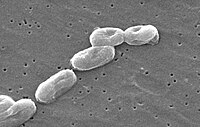
Photo from wikipedia
Pseudomonas aeruginosa is a prominent cystic fibrosis (CF) pathogen that uses quorum sensing (QS) to regulate virulence. In laboratory strains, the key QS regulator is LasR. Many isolates from patients… Click to show full abstract
Pseudomonas aeruginosa is a prominent cystic fibrosis (CF) pathogen that uses quorum sensing (QS) to regulate virulence. In laboratory strains, the key QS regulator is LasR. Many isolates from patients with chronic CF infections appear to use an alternate QS circuitry in which another transcriptional regulator, RhlR, mediates QS. We show that a LasR-null CF clinical isolate engages in QS through RhlR and remains capable of inducing cell death in an in vivo-like lung epithelium cell model. Our findings support the notion that LasR-null clinical isolates can engage in RhlR QS and highlight the centrality of RhlR in chronic P. aeruginosa infections. ABSTRACT The opportunistic pathogen Pseudomonas aeruginosa is a leading cause of airway infection in cystic fibrosis (CF) patients. P. aeruginosa employs several hierarchically arranged and interconnected quorum sensing (QS) regulatory circuits to produce a battery of virulence factors such as elastase, phenazines, and rhamnolipids. The QS transcription factor LasR sits atop this hierarchy and activates the transcription of dozens of genes, including that encoding the QS regulator RhlR. Paradoxically, inactivating lasR mutations are frequently observed in isolates from CF patients with chronic P. aeruginosa infections. In contrast, mutations in rhlR are rare. We have recently shown that in CF isolates, the QS circuitry is often rewired such that RhlR acts in a LasR-independent manner. To begin understanding how QS activity differs in this rewired background, we characterized QS activation and RhlR-regulated gene expression in P. aeruginosa E90, a LasR-null, RhlR-active chronic infection isolate. In this isolate, RhlR activates the expression of 53 genes in response to increasing cell density. The genes regulated by RhlR include several that encode virulence factors. Some, but not all, of these genes are present in the QS regulon described in the well-studied laboratory strain PAO1. We also demonstrate that E90 produces virulence factors at similar concentrations as PAO1, and in E90, RhlR plays a significant role in mediating cytotoxicity in a three-dimensional lung epithelium cell model. These data illuminate a rewired LasR-independent RhlR regulon in chronic infection isolates and suggest further investigation of RhlR as a possible target for therapeutic development in chronic infections. IMPORTANCE Pseudomonas aeruginosa is a prominent cystic fibrosis (CF) pathogen that uses quorum sensing (QS) to regulate virulence. In laboratory strains, the key QS regulator is LasR. Many isolates from patients with chronic CF infections appear to use an alternate QS circuitry in which another transcriptional regulator, RhlR, mediates QS. We show that a LasR-null CF clinical isolate engages in QS through RhlR and remains capable of inducing cell death in an in vivo-like lung epithelium cell model. Our findings support the notion that LasR-null clinical isolates can engage in RhlR QS and highlight the centrality of RhlR in chronic P. aeruginosa infections.
Journal Title: mBio
Year Published: 2020
Link to full text (if available)
Share on Social Media: Sign Up to like & get
recommendations!